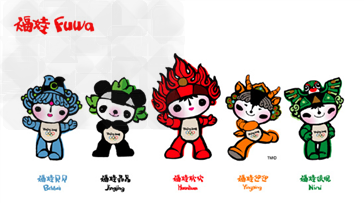
Five Olympic mascots were announced exactly 1000 days before the Beijing Olympic opening
ceremony. The long-anticipated mascots represent four of China's most popular animals—the fish, the
panda, the Tibetan antelope and the swallow. The fifth mascot is the brightly burning Olympic flame.
Each of the mascots has a repeated two-syllable name. This type of name is a traditional way of
showing affection for children in China. BeiBei is the fish, JingJing is the panda, HuanHuan is the Olympic
flame, YingYing is the Tibetan antelope and NiNi is the swallow. The first characters of their two-syllable
names read "Beijing Huanying Ni," or, in English, "Welcome to Beijing."
The five elements of nature, including the sea, forest, fire, earth and sky are found in the mascot's
origins and headpieces. These special headpieces also display the folk and culture of China. Each mascot
also symbolizes a different blessing —prosperity, happiness, passion, health and good luck.
It is the first time more than three mascots will share the important duty of representing their host
country. Han Meilin, chief of the mascot design team explained that, "China has such a rich culture that no
single mascot could possibly represent it! That is why we chose to produce five mascots instead of one."
Called the "Five Friendlies," the figures embody(体现) the Chinese people's hope for peace and
friendship in the world and the spirit of the Olympics, representing not only multi-ethnic(多民族的)
cultures of China, but also the traditional Chinese philosophy of harmony between humans and nature.
In order to help Beijing 2008 spread its theme of One World, One Dream to every continent, the Five Friendlies reflect the deep desire of the Chinese people to reach out to the world in friendship through the Games - and to invite every man, woman and child to take part in the great celebration of human union in
2008.
1. What's the theme of Beijing 2008 Olympics?
A. Welcome to Beijing.
B. Prosperity, Happiness, Passion, Health and Good luck.
C. New Beijing, New Olympics.
D. One World, One Dream.
2. What did Han Meilin, chief of the mascot design team, think of the five mascots?
A. He thought highly of the five mascots.
B. No single mascot could represent China.
C. The five mascots represented the culture of China.
D. They would reflect the desire of Chinese people.
3. Which of the following statements is not true?
A. It's for the first time that five mascots are chosen to represent their host country in the Olympic history.
B. One of the five mascots YingYing stands for the Olympic flame.
C. Beijing announced its five 2008 Olympic mascots just 1000 days before the big event.
D. The five mascots express affection for Chinese children by two-syllable names.
4. Which of the following best reflects the main idea of the passage?
A. The 29th Olympic Games will be held in Beijing in 2008.
B. The theme of 2008 Beijing Olympics - One World, One Dream.
C. The significance of five 2008 Olympic mascots - the Five Friendlies.
D. How the Five Fantastic Mascots came into being.
5. What do the five mascots - the Five Friendlies represent?
A. "Beijing Huanying Ni," or, in English, "Welcome to Beijing."
B. Chinese multi-ethnic cultures, philosophy of harmony between humans and nature and five elements
of nature.
C. Chinese people's hope for peace and friendship in the world and the spirit of the Olympics.
D. The deep desire of the Chinese people to reach out to the world in friendship through the Olympics.
1-5: DABCB
